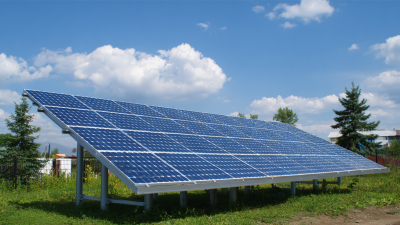The Ultimate Guide to Choosing the Right Solar PV Battery for Your Home
In recent years, the adoption of solar PV systems has surged, driven by technological advancements and increasing energy costs. As homeowners seek energy independence and sustainability, the integration of solar PV batteries has become essential for maximizing the efficiency of solar power systems.
According to a report by the International Renewable Energy Agency (IRENA), the global market for solar energy storage is projected to reach over $10 billion by 2025, highlighting the growing importance of solar PV batteries in residential applications.
 These batteries not only store excess energy produced during the day for use at night but also provide backup power during outages. Choosing the right solar PV battery is crucial for optimizing both energy savings and system performance, making this guide an indispensable resource for homeowners looking to harness the full potential of solar energy.
These batteries not only store excess energy produced during the day for use at night but also provide backup power during outages. Choosing the right solar PV battery is crucial for optimizing both energy savings and system performance, making this guide an indispensable resource for homeowners looking to harness the full potential of solar energy.
Factors Influencing the Selection of Solar PV Batteries for Residential Use
When selecting the right solar PV battery for residential use, several key factors come into play. First, the capacity of the battery is crucial. Homeowners must consider their energy consumption patterns and aim for a battery that can store enough energy to meet their needs during peak usage times, especially when solar generation is lower, such as at night or during cloudy days. Additionally, the depth of discharge, or the percentage of battery capacity that can be used without harming the battery's lifespan, is an important consideration in ensuring long-term efficiency.
Another significant factor is the battery's cycle life, which indicates how many charging and discharging cycles the battery can handle before its capacity diminishes. This directly impacts the battery's longevity and overall cost-effectiveness. Homeowners should also evaluate the battery chemistry, as different types such as lithium-ion or lead-acid come with distinct characteristics regarding efficiency, lifespan, and maintenance requirements. Finally, system compatibility with existing solar PV setups and monitoring features should be assessed, as these can enhance the user experience and overall integration into home energy systems.
Understanding Battery Chemistry: Lead-Acid vs. Lithium-Ion in Solar Systems
When selecting the right solar PV battery for your home, understanding the differences between lead-acid and lithium-ion batteries is crucial. Lead-acid batteries, despite facing stiff competition from lithium-ion technology, remain a viable option in the solar market due to their lower upfront costs—often 40% to 50% less than their lithium-ion counterparts. Recent advancements in lead-acid technology, including sound-assisted charging methods, have revitalized their performance and longevity, making them a practical choice for many homeowners looking for cost-effective energy storage solutions.

On the other hand, lithium-ion batteries dominate the residential energy storage scene, weighing heavily in terms of efficiency and cycle life. They are recognized for their rapid charge and discharge capabilities, which allow for better integration with solar systems. With the ongoing growth of the portable power supply market projected through to 2034, lithium-ion technology continues to capture a larger share, driven by the demand for reliable and high-capacity energy solutions. According to industry forecasts, the battery market will see extensive growth and innovation, making it essential for homeowners to match the right battery chemistry with their specific energy needs and financial considerations.
Evaluating the Capacity and Power Ratings Needed for Your Home's Energy Needs
When choosing a solar PV battery for your home, it’s crucial to evaluate both capacity and power ratings to match your energy needs. Capacity, measured in kilowatt-hours (kWh), indicates how much energy the battery can store, while power rating, expressed in kilowatts (kW), reflects the rate at which energy can be drawn. According to a report by the U.S. Department of Energy, a typical American household consumes about 30 kWh per day. Therefore, aiming for a battery capacity that can cover at least one day’s worth of usage is essential for energy security.
Tip: Assess your energy consumption patterns. Utilize an energy monitor or review recent utility bills to determine your daily electricity usage. This will enable you to choose a battery with suitable capacity to meet your specific requirements.
Power ratings also play a vital role, especially during peak usage times. If your household frequently relies on high-demand devices, like air conditioners or electric ovens, a higher power rating will ensure that these appliances can function without interruptions. The Solar Energy Industries Association suggests that most home systems should aim for power ratings that can handle at least 2 to 3 kW occasionally to avoid energy gaps.
Tip: Consider your peak load requirements. Calculate the simultaneous operation of devices you might use during power outages to ensure that your battery choice aligns with your peak demand needs.

The Importance of Depth of Discharge (DoD) in Maximizing Battery Lifespan
When selecting a solar PV battery for your home, understanding the Depth of Discharge (DoD) is crucial to maximizing its lifespan. DoD refers to the percentage of the battery's total capacity that can be used before it needs to be recharged. Essentially, the lower you discharge your battery, the longer it will last—an important consideration for homeowners looking to make a long-term investment.
**Tips:** To enhance the longevity of your solar battery, aim to maintain a DoD of around 50%. This means if you have a 10 kWh battery, try to use no more than 5 kWh before recharging it. Additionally, consider the daily cycle of energy use in your household and choose a battery that can comfortably accommodate your needs without consistently hitting its maximum discharge limit.
Another important factor is to choose a battery with a high DoD rating. Lithium-ion batteries typically offer a DoD of 80-90%, allowing for more usable energy without significantly impacting the battery’s health. This feature can give you greater flexibility in energy management, ensuring that your solar power system runs efficiently while prolonging the life of your investment.
The Impact of Depth of Discharge (DoD) on Battery Lifespan
This chart illustrates how the Depth of Discharge (DoD) affects the lifespan of solar PV batteries. Generally, a lower DoD results in a significantly higher number of charge cycles before the battery needs replacement, highlighting the importance of managing discharge levels to maximize battery life.
Comparing Warranty and Lifespan Expectations for Different Solar Battery Brands
When selecting the right solar PV battery for your home, understanding the warranty and lifespan expectations of different brands is crucial. Many homeowners often overlook the significance of these factors, yet they can significantly impact overall satisfaction and cost-effectiveness in the long run. Brands offering longer warranty periods, such as those with warranties extending to 20 years, can provide added peace of mind, indicating confidence in their product's longevity and reliability.
The lifespan of solar batteries is another critical aspect to consider. While some batteries may initially seem affordable, their longevity and performance degrade over time, resulting in the need for replacements sooner than expected. Investing in batteries known for durability can ensure that your energy storage solutions serve your home effectively for many years. Additionally, reliable backup power during outages makes choosing the right battery even more vital, as it can mean the difference between comfort and inconvenience during an emergency.
Related Posts
-

How to Maximize Energy Efficiency with PV Tiles: Insights and Innovations in Solar Technology
-

Ultimate Guide to Solar PV Battery Comparisons for Global Procurement Insights
-

What Makes Solar Panel Tiles a Smart Choice for Sustainable Energy Solutions
-

How to Maximize Efficiency with Solar Thermal Panels in Your Home
-

How to Secure Solar Panel Grants for Your Home Energy Needs
-

Revolutionizing Energy Efficiency with Photovoltaic Roof Tiles and Their Impact on Future Sustainability